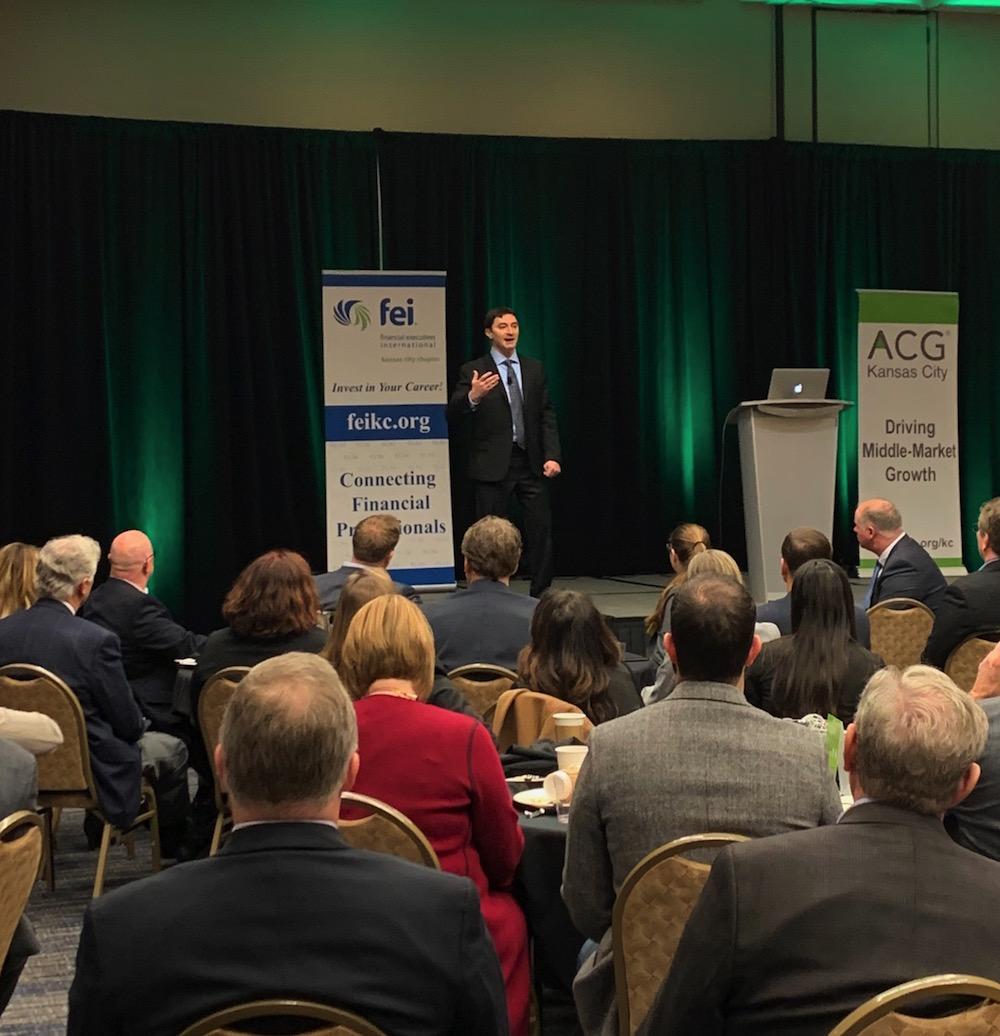

According to Alex Chausovsky, a senior consulting advisor at ITR Economics, the record-setting growth the U.S. economy has enjoyed over the last 27 months is coming to an end. However, the news isn’t all bad.
“The business tailwind you’ve experienced in your sales in the last 18-24 months will change as the economy becomes a headwind in the later part of 2019 and into mid-2020,” Chausovsky told a packed house at the recent ACG Annual Economic Forecast Breakfast. “For the most part, growth rates will remain above that all-important ‘zero line,’ so this is really an opportunity to catch our collective breath and prepare for the next rise. The question for each of you is: What do I need to do to get my business ready for the next rise?”
Identifying and adjusting
Chausovsky said the key to surviving and thriving in a down cycle is identifying what drives the demand forces in your industry and adjusting the benchmarks you set. While ITR isn’t calling for an all-out recession, Chausovsky said there is potential for negativity in the industrial, manufacturing and utilities sectors. Data from The Great Recession of 2008 shows a marked diversion between the consumer markets, which performed moderately, versus the industrial sector, which took a significant hit.
“We are expecting (an industrial/manufacturing sector downturn) to happen again,” Chausovsky said. “It will not be significantly negative, but negative nonetheless.
Ask yourself what it is that drives your company’s performance and benchmark yourself and your business to that data,” he said. “If you’re focused on the business-to-consumer segment, the slowdown may not affect you as much, but if you’re focused on the B2B sector, you need to be planning for it.”
Chausovsky and his ITR colleagues are certain a slowdown is approaching because their indicator—an index compiled of several well-respected formulas combined with industry information they gather—has correctly predicted results since before 2006. In layman’s terms, the indicator forecasts how industry will perform 1-2 months in the future.
Breaking the results down for the audience, Chausovsky showed how the month-to-month G7 index (one of the formulas used in ITR’s indicator), shows it has already “turned over and gone into the negative,” as has the US IP, the JP Morgan manufacturing index and the PMI.
“This shows that the slowdown is already happening in the rest of world and that the good times are coming to an end,” he said. “So now we must take a defensive position and adapt for what’s coming.”
The power of perspective
Chausovsky was a 10-year-old Ukrainian immigrant who hardly spoke a word of English when, in 1990, he found himself standing on the floor of the arena at a Dallas-area rodeo.
“I’m fresh off the boat at this rodeo—wondering why human beings would wrestle with cattle—when a call goes out for the kids to go down to the floor,” he said. “So everyone’s urging me on and I figured ‘Let’s check it out, I’m up for anything.’”
Chausovsky said he found himself surrounded by a throng of other children, many dressed in full Western garb.
“Most of the younger kids were dressed casual like me, but those older kids were serious—wearing cowboy hats, belt buckles and the whole outfit,” he said. “Then they rang the bell and a calf ran in and everyone started to run at it, chasing it around the side of the arena along the wall.”
“So I’m standing there and I have no idea what’s going on, but pretty quickly I start to read the contextual clues. I see that the calf has a blue ribbon in one ear and think, ‘I better get that ribbon.’”
So young Chausovsky broke into a dead run—taking a perpendicular line—intent on intercepting the calf. As he closed the gap, he began to realize the folly of running into such a huge animal.
“So I did the only thing I could think of. I lowered my shoulder and slammed straight into its side, knocking it off its feet,” he said. “Then I got that ribbon and proudly stood up. The audience was in shocked silence, but I eventually started to get a clap or two. That’s a totally true story…and the reason I told you is this: Knowing what to do, reading the clues, is vitally important to achieving success.”
The bad news can be an opportunity
The tax breaks that extended the current state of economic growth did so at a cost, and that bill will soon come due.
“Much of the boost came from depreciation as companies wrote off used equipment or asset purchases, and therefore offered an uncommon nudge in investments,” Chausovsky explained. “But now there is less tax revenue coming into government coffers and the American government is spending beyond what it makes, and that’s not sustainable.”
In fact, Chausovsky said, 1945 was the last time the U.S. National Debt trended this high.
“I think it makes sense to take on that much debt when you’re fighting to protect democracy, but when your economy is growing at three percent? In my personal opinion, we’re robbing Peter to pay Paul.”
The takeaway, Chausovsky said, is to get prepared. Pay down debt, make sure you have as much cash on hand as possible, and avoid extending yourself on things like long-term leases.
“Be ready to buy,” he said. “Recessions are actually good for people who can capitalize. If you plan and position, you can prosper. The key is knowing rates of change and being aggressive in the low point of the business cycle.”

Register by January 14 to maximize value, elevate your experience, and get a head start connecting with 3,200+ dealmakers and executives.
